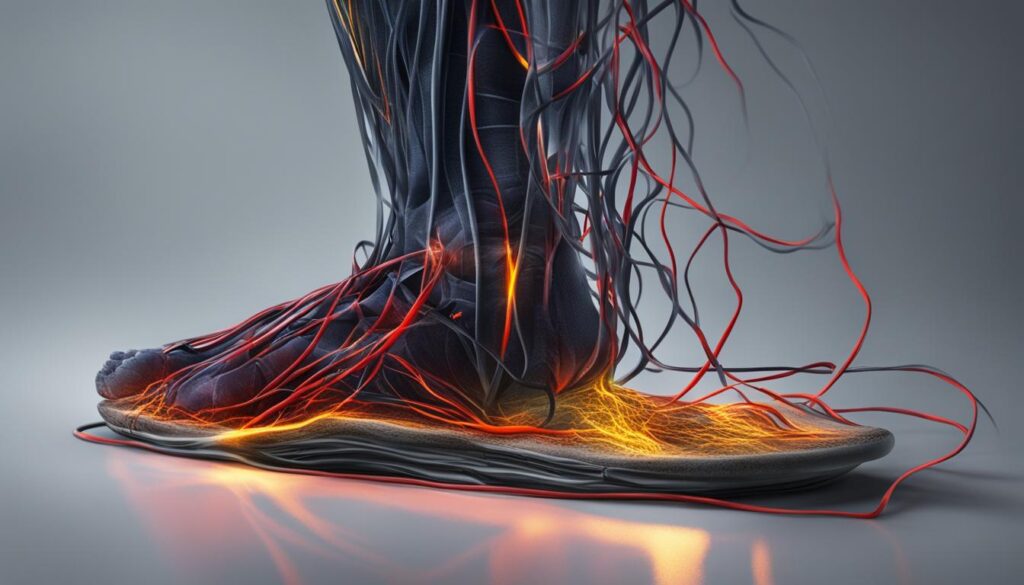Have you ever been taken by surprise with a painful foot cramp, leaving you hobbling in discomfort? Foot cramps are sudden, involuntary muscle contractions that can occur in different parts of the foot, including toes, arches, and tops. Common foot cramp triggers range from wearing shoes that are too tight, dehydration, overexertion, low potassium, nerve damage, to certain medications. While these painful spasms can significantly hinder mobility and quality of life, understanding their causes and applying effective foot cramp relief measures can help manage their occurrence.
Stretching and massaging the afflicted area can offer immediate relief from occasional cramps, but it’s important to heed persistent cramps as they might signal underlying health issues. In such cases, promptly seeking a doctor’s advice is necessary for appropriate treatment and prevention strategies.
Key Takeaways
- Foot cramps are sudden and involuntary muscle spasms causing pain and impaired mobility.
- Common triggers include dehydration, ill-fitting shoes, overexertion, low potassium levels, nerve damage, and certain medications.
- Treating foot cramps often involves measures like stretching and massage.
- Persistent foot cramps warrant a check-up with a medical professional to address possible underlying health conditions.
- Understanding the triggers and symptoms of foot cramps is key to their effective management and relief.
Understanding Foot Cramps: An Overview
Foot cramps, often experienced as harsh, unwelcome interruptions in the course of our daily routines or peaceful sleep, can be a source of intense discomfort and distress. It’s crucial to understand the causes, manifestation, and potential natural remedies for foot cramps, in order to effectively treat and prevent them. This section aims to outline a comprehensive understanding of the various aspects of foot muscle cramps.
Definition and Symptoms of Foot Cramps
Foot cramps are characterized by sudden and painful involuntary muscle contractions experienced primarily in the arches and toes of the feet. These muscle spasms, commonly referred to as “Charley horses,” can last anywhere from a few seconds to several agonizing minutes. The principal cause of foot cramps encompass a range of factors from dehydration and overexertion to wearing improper footwear. Symptoms typically include a sudden, sharp pain accompanied by a tight or tensed feeling in the affected muscles.
Common Areas Affected by Foot Cramps
While foot cramps can sporadically occur in different regions of the foot, the arch and toes are the most commonly affected areas. However, in some instances, the unsettling sensation of a cramp can also extend to envelop the calf muscles. When this occurs during the night, they are referred to as nocturnal cramps, leading to disrupted sleep and subsequent fatigue.
The following table gives an overview of the common regions affected by foot cramps:
| Region | Occurrence |
|---|---|
| Arches of the feet | Most common |
| Toes | Common |
| Calf Muscles | Less common, often nocturnal |
The Impact of Foot Cramps on Daily Life
Both persistent and severe foot cramps can have notable implications on quality of life. With potential to cause significant sleep disturbances and limit mobility, these cramps and the related discomfort they bring may hinder daily activities and overall productivity. However, by employing natural remedies for foot cramps and making certain lifestyle changes, it is possible to reduce the frequency and intensity of these muscle spasms, significantly mitigating their impact on daily life.
Identifying the Main Foot Cramp Triggers
Knowing the root causes is a crucial step in effective foot cramp prevention. Triggers of these painful spasms can range from lifestyle habits to underlying health conditions. By recognizing and addressing these triggers, it becomes significantly easier to prevent foot cramps.
Firstly, consider your day-to-day activities. Overexertion through sustained physical activity or standing for prolonged periods without adequate rest can lead to muscle fatigue and subsequent cramping. Pair this with external factors like heat or inadequate fluid intake, and the risk of experiencing foot cramps increases exponentially.
Remember, dehydration is a common foot cramp trigger! To prevent foot cramps, ensure that you’re drinking enough water, particularly during periods of intense physical activity.
“Adequate hydration, combined with regular, moderate exercise, can often prevent foot cramps before they start.”
Footwear is another influencing factor that’s often overlooked. Ill-fitted or uncomfortable shoes can strain the feet and contribute to cramping. A solution often lies in choosing footwear that provides adequate support, comfort, and room for your feet to breathe.
Foot cramp prevention also involves paying attention to the body on a more holistic level. Imbalances in electrolyte levels (often caused by specific conditions or medications) can provoke foot cramps. Understanding your body, including any existing health conditions such as endocrine disorders or nerve-related issues, can assist in identifying potential cramp triggers.
- Maintain adequate hydration.
- Choose comfortable, supportive footwear.
- Manage your physical activity levels.
- Consult a healthcare professional to discuss any relevant medical conditions or medication side effects.
These steps can be incredibly helpful in helping to prevent foot cramps. The groundwork for foot cramp prevention starts with assessing and understanding our habits and body. By identifying potential triggers, we can not only manage foot cramps but also improve our overall health and wellbeing.
Shoe Fit and Footwear: Can Your Shoes Cause Cramps?
Footwear plays a significant role in foot health, especially for people who frequently experience foot cramps. Shoes that are too tight or ill-fitting tend to constrict movement and circulation, potentially leading to cramps. This section thus highlights the importance of picking suitable footwear to treat foot cramps and demonstrates how supportive insoles can further aid in foot cramp prevention.
The Role of Shoe Fit in Foot Health
The fitting of your shoes can directly influence your foot health. Shoes that are too tight, too loose, or don’t adequately support certain points of the foot may lead to a variety of foot problems, including cramps. Properly fitting shoes should ideally have a snug but not tight fit around your foot, leaving enough room for your toes to move freely.
Choosing the Right Footwear to Prevent Cramps
Prioritizing comfort and good fit is crucial when shoe shopping to prevent foot cramps. Ideally, footwear should conform to the natural shape of your foot, offering thorough support and cushioning. Emphasis should be given to arch support and sufficient toe room to help alleviate the strain that can cause cramps, especially after long walking or standing periods.
Supportive Insoles and Their Benefits
Insoles can add further benefits to foot health, particularly for those prone to foot cramps. Designed to offer extra support to your feet when placed inside your shoes, insoles can significantly alleviate the strain on your feet. They can particularly help in reducing the incidence of foot cramps related to extensive walking or standing periods. Investing in a custom or semi-custom insole can be a game-changer for foot cramp prevention.
| Footwear Aspect | Role in Foot Cramp Prevention |
|---|---|
| Proper Fit | Ensures good circulation, prevents unnatural constrictions or strains |
| Good Support | Reduces strain on the feet and legs, helping to prevent cramps |
| Adequate Toe Room | Allows natural movement of toes, preventing cramps induced by constriction |
| Arch Support (Insoles) | Relieves strain off the arches, thus reducing the likelihood of cramps |
In conclusion, choosing the right footwear and insoles plays an essential role in managing and preventing foot cramps. By giving priority to factors such as shoe fit, comfort, and support, it is possible to effectively treat foot cramps, mitigate their recurrence, and promote overall foot health.
Hydration and Nutrition: Essential for Preventing Foot Cramps
When it comes to treating foot cramps, there are numerous natural remedies for foot cramps. One of the fundamental steps you can actively take is to ensure that your body stays adequately hydrated. Since hydration is a key factor in maintaining regular muscle function, dehydration can serve as a direct trigger for foot cramps. Therefore, regular intake of fluids and staying well-hydrated can greatly help in preventing the onset of foot cramps.

Apart from hydration, another crucial determinant of muscle health is a well-balanced diet that is rich in electrolytes, particularly potassium, calcium, and magnesium. It is worth noting that low dietary intake of these essential electrolytes can lead to an imbalance, thereby causing muscle cramps in the foot. By managing your intake of these nutrients, either by incorporating them in your diet or by taking suitable supplements under professional guidance, you can effectively avoid the occurrence of foot cramps. Let’s delve into some foods beneficial for each key electrolyte.
| Potassium Rich Foods | Calcium Rich Foods | Magnesium Rich Foods |
|---|---|---|
| Bananas | Yogurt | Spinach |
| Sweet Potatoes | Cheese | Legumes |
| Avocados | Milk | Dark Chocolate |
| Orange Juice | Sardines | Seeds |
By integrating these actions with the aforementioned natural remedies for foot cramps, you can construct an effective strategy for treating foot cramps and ensuring the proper health of your feet.
Exercise and Overexertion: How Physical Activity Influences Cramps
Striking a balance when it comes to physical activity is pivotal to managing foot cramps. Exercise can be seen as a two-edged sword in the context of foot cramps. When done right, it serves as an excellent preventive measure. However, overexertion without proper rest and strain management can trigger cramps.
Finding the Right Exercise Balance
Understanding the limits of your body and respecting them when participating in physical activity is critical. The key to success lies in moderating the exertion and giving the body ample time to recuperate. Exercises for foot cramps like calf stretches, toe extensions, and foot flexes can be beneficial. It’s important to gradually ramp up the intensity of your workout routine to avoid sudden strain on your foot muscles.
Importance of Warm-Up and Cool-Down Routines
A rigorous exercise routine demands a proper warm-up before starting and a cool-down period after finishing. Skipping these crucial steps increases the risk of muscle strain and fatigue, which in turn can lead to foot cramps. Warm-ups prepare your muscles for the work ahead, while cool-down exercises help return your heart rate and breathing to normal and lessen the chances of muscle stiffness.
Recognizing Signs of Overexertion
When it comes to avoiding foot cramps, vigilance about overexertion symptoms is key. These signs can include excessive general fatigue that continues even after rest, heightened muscle discomfort, sudden foot pains, and cramps. Recognizing these early on can prevent undue strain and more serious injuries, aiding in effectively managing foot cramps.
The Link Between Health Conditions and Foot Muscle Cramps
In understanding the diverse causes of foot cramps, it’s important not to overlook the role health conditions play. Numerous health issues directly impact the muscle and nerve functioning, often manifesting as painful foot spasms. In this section, we will dive into a few common health conditions that could be the underlying precipitators of your foot cramps.
Peripheral Neuropathy and Foot Cramps
 Peripheral Neuropathy, more commonly seen in individuals with diabetes, often presents with pain that may mimic that of muscle cramps. The nerve damage inflicted by the disease disrupts the normal functioning of nerves, leading to uncomfortable sensations in the feet, which can be mistaken for cramps.
Peripheral Neuropathy, more commonly seen in individuals with diabetes, often presents with pain that may mimic that of muscle cramps. The nerve damage inflicted by the disease disrupts the normal functioning of nerves, leading to uncomfortable sensations in the feet, which can be mistaken for cramps.
Electrolyte Imbalances and Their Effects
Healthy muscle functioning relies heavily on the correct balance of electrolytes. Conditions that result in an electrolyte imbalance, such as diarrhea, cirrhosis, or kidney problems requiring dialysis, disrupt the proper activation of muscle fibers. This imbalanced state can subsequently evoke spasms in the foot muscles.
Endocrine Disorders and Muscle Health
Endocrine disorders such as hyperthyroidism and Addison’s disease directly impact the levels of hormones and electrolytes in the body. Both hormones and electrolytes are paramount to maintaining muscle health. Any fluctuation in their levels can potentially result in muscle cramping, including in the feet.
Several natural remedies for foot cramps are available that aim to address these underlying health issues and help maintain the necessary balance in the body. Remember to always consult a healthcare professional before starting any new health regimen.
| Health Condition | Description | Link to Foot Cramps |
|---|---|---|
| Peripheral Neuropathy | Usually associated with diabetes, it causes nerve damage. | Pain mimicking muscle cramps as nerves in feet malfunction. |
| Electrolyte Imbalances (Diarrhea, Cirrhosis, Dialysis) | Conditions that disrupt the balance of electrolytes in the body. | Disrupts proper muscle fiber activation, causing spasms. |
| Endocrine Disorders (Hyperthyroidism, Addison’s Disease) | Diseases that affect hormone and electrolyte levels. | Impacts muscle health, possibly leading to muscle cramping. |
Conclusion
Contending with foot cramp triggers often comes down to making healthy lifestyle changes, donning the correct footwear, and maintaining optimal wellness. Something as straightforward as keeping your body hydrated, ensuring a well-rounded diet, wearing shoes that fit properly, and being conscious of your own physical limitations can significantly lower the chances of experiencing foot cramps. These simple actions can be instrumental in finding foot cramp relief.
However, it’s imperative to remember that ongoing or severe cramps could be a sign of underlying health issues or even a side effect of certain medications. In such cases, it becomes crucial to seek professional advice. Diagnosis and treatment of the root cause are paramount to effectively treat foot cramps.
Foot cramps need not be a recurrent issue hindering your daily routine. With a keen understanding of the triggers coupled with appropriate management strategies, it’s possible to significantly reduce their occurrence and impact. Continual well-being starts with mindfulness about your body and the potential signals it sends out. Always prioritizing your health can lead to improved functionality and a considerably enhanced quality of life.





